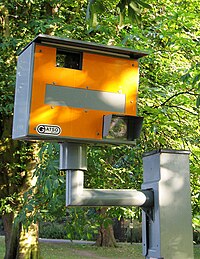
Photo from wikipedia
ABSTRACT Objective: The conflicts among motorists entering a signalized intersection with the red light indication have become a national safety issue. Because of its sensitivity, efforts have been made to… Click to show full abstract
ABSTRACT Objective: The conflicts among motorists entering a signalized intersection with the red light indication have become a national safety issue. Because of its sensitivity, efforts have been made to investigate the possible causes and effectiveness of countermeasures using comparison sites and/or before-and-after studies. Nevertheless, these approaches are ineffective when comparison sites cannot be found, or crash data sets are not readily available or not reliable for statistical analysis. Considering the random nature of red light running (RLR) crashes, an inventive approach regardless of data availability is necessary to evaluate the effectiveness of each countermeasure face to face. Method: The aims of this research are to (1) review erstwhile literature related to red light running and traffic safety models; (2) propose a practical methodology for evaluation of RLR countermeasures with a microscopic traffic simulation model and surrogate safety assessment model (SSAM); (3) apply the proposed methodology to actual signalized intersection in Virginia, with the most prevalent scenarios—increasing the yellow signal interval duration, installing an advance warning sign, and an RLR camera; and (4) analyze the relative effectiveness by RLR frequency and the number of conflicts (rear-end and crossing). Results: All scenarios show a reduction in RLR frequency (−7.8, −45.5, and −52.4%, respectively), but only increasing the yellow signal interval duration results in a reduced total number of conflicts (−11.3%; a surrogate safety measure of possible RLR-related crashes). An RLR camera makes the greatest reduction (−60.9%) in crossing conflicts (a surrogate safety measure of possible angle crashes), whereas increasing the yellow signal interval duration results in only a 12.8% reduction of rear-end conflicts (a surrogate safety measure of possible rear-end crash). Conclusions: Although increasing the yellow signal interval duration is advantageous because this reduces the total conflicts (a possibility of total RLR-related crashes), each countermeasure shows different effects by RLR-related conflict types that can be referred to when making a decision. Given that each intersection has different RLR crash issues, evaluated countermeasures are directly applicable to enhance the cost and time effectiveness, according to the situation of the target intersection. In addition, the proposed methodology is replicable at any site that has a dearth of crash data and/or comparison sites in order to test any other countermeasures (both engineering and enforcement countermeasures) for RLR crashes.
Journal Title: Traffic Injury Prevention
Year Published: 2018
Link to full text (if available)
Share on Social Media: Sign Up to like & get
recommendations!